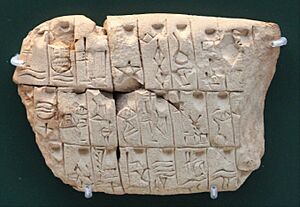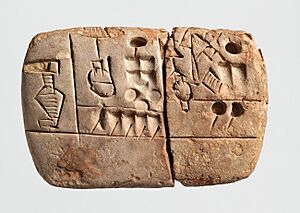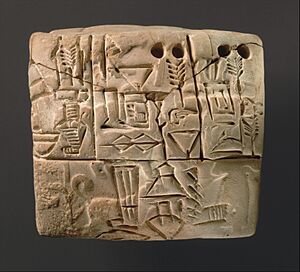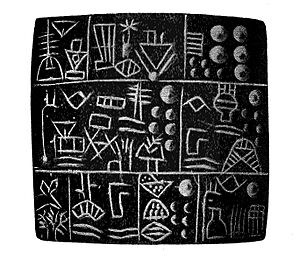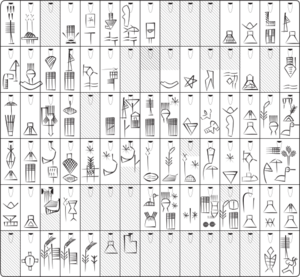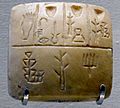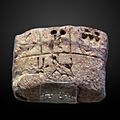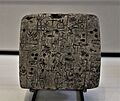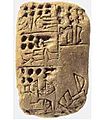Proto-cuneiform facts for kids
Quick facts for kids Proto-cuneiform |
|
|---|---|
| [[Image:Tableta_con_trillo.png|]]
Kish Tablet
|
|
| Type | Ideographic |
| Spoken languages | Unknown, possibly Sumerian |
| Time period | c. 3500–2900 BC |
| Child systems | Cuneiform |
| ISO 15924 | Pcun |
| Note: This page may contain IPA phonetic symbols in Unicode. | |
The proto-cuneiform script was a system of proto-writing that emerged in Mesopotamia, eventually developing into the early cuneiform script used in the region's Early Dynastic I period. It arose from the token-based system that had already been in use across the region in preceding millennia. While it is known definitively that later cuneiform was used to write the Sumerian language, it is still uncertain what the underlying language of proto-cuneiform texts were.
Contents
History
During the 9th millennium BC, a token-based system came into use in various parts of the ancient Near East. These evolved into marked tokens, and then into marked envelopes now known as clay bullae. It is usually assumed that these were the basis for the development of proto-cuneiform, as well as of the contemporaneous Proto-Elamite writing system: as many as two-thirds of the tokens discovered have been excavated in Susa, the most important city in what would become Elam. These tokens continued to be used, even after the development of proto-cuneiform and Proto-Elamite. A single fragmentary slab at the Uruk site of Hacınebi has been proposed as a numerical tablet.
The earliest tablets found, in the Uruk V period, are of a 'numerical' character. They consist only of lists of numbers associated with 18 known signs (circles, triangles etc), sometimes sealed. It has been suggested that they appeared as early as the Uruk IV period and remained in use until the Uruk IVa period. Generally they are called "numerical tablets" or "impressed tablets". They have been mostly found in Susa (75) and Uruk (58) (small numbers in Jemdat Nasr (2), Chogha Mish (1), Tepe Sialk (10), Tutub (1) and Mari (1)) including some that lack later Proto-Elamite and proto-cuneiform tablets, like Tell Brak (1), Habuba Kabira (3), Tepe Hissar, Godin Tepe (38), Nineveh (1), and Jebel Aruda (13). A few unprovenanced tablets are held in private collections.
Proto-cuneiform emerged in what is now labeled the Uruk IV period (c. 3300 BC), and its use through the later Uruk III period. The script slowly evolved over time, with signs changing and merging. It was used for the first time in Uruk, later spreading to additional sites such as Jemdet Nasr.
With the advent of the Early Dynastic period c. 2900 BC, the standard cuneiform script used to write the Sumerian language emerged, though only about 400 tablets have been recovered from this period; these are mainly from Ur, with a few from Uruk. Thus, the 5000 years from the emergence of tokens to full cuneiform writing was about equal to the 5000 years since then.
Language
[[File:Pictographs Recording the Allocation of Beer (London, England).jpg|thumb|Proto-cuneiform tablet recording the allocation of beer]] There is a longstanding debate in the academic community regarding when the Sumerian people arrived in Mesopotamia. Partly spurred by linguistic arguments and evidence, overall it is generally clear that a number of fundamental changes occurred in Mesopotamia—such as the use of the plano-convex brick—at the same time the first definitive evidence of the Sumerian language appeared during the Early Dynastic I period. Proto-cuneiform offers no clear clues as to what spoken language it encoded, leading to much speculation, though Sumerian is often assumed.
Corpus
About 170 similar tablets from Uruk V (c. 3500 BC), Susa, and other Iranian sites like Tepe Sialk, are considered to be pre-Proto-Elamite, though bearing similarities to proto-cuneiform. Sign lists and transliterations are less clear for this category.
Like Proto-Elamite, the system's propagation was relatively limited. The vast majority of the proto-cuneiform texts found, about 4000, have been located in archaic Uruk, though also in secondary contexts within the Eanna district. The tablets fall primarily into two styles: the earlier (building level IV) set featuring more naturalistic figures, written with a pointed stylus, and the later set (building level III) with a more abstract style, made using a blunt stylus. These correspond to the Late Uruk c. 3100 BC and Jemdet Nasr c. 3000 BC periods respectively. Many of the tablets were themselves later used as foundation filler during the construction of the Uruk III Eanna temple complex. It appears that the records were considered to be of transient utility or interest, and were quickly disposed of. The difficult stratigraphy has brought about a change from referring to tablets based on excavation layer to one of calling them script phase IV and III. Similarly to the tablets, clay seals previously used to secure vessels and doors ended up in the fill after being removed. The sites and analysis of sealing has led to suggestions that the tablets originated elsewhere and ended up at Uruk, where they were discarded.
A smaller number of tablets were found in Jemdet Nasr (2 Uruk V, 236 Uruk III), Umma, Eshnunna (2 Uruk III), Larsa (23 Uruk III), Khafajah, Kish (5 Uruk III), and Tell Uqair (39 Uruk III). They tend to be less fragmentary and are sometimes found in stratified contexts. Some have made their way into various private and public collections: the provenance for some can be determined from internal clues, but for some the origin city is unknown. For example, in 1988 82 complete well-preserved tablets from the Swiss Erlenmeyer Collection in Basel were auctioned off with most ending up in public collections.
A notable exemplar was found by Langdon during his excavation in the 1920s, often called the "Kish tablet". A plaster-cast of the artifact is presently held in the collection of the Ashmolean Museum, with the original at the Baghdad Museum. Its date of origin is unclear.
Some tablets were sealed using a cylindrical seal.
State of decipherment
To decipher an unknown, fully functional writing system, scholars usually need some knowledge of the underlying spoken language, some bilingual texts, and a large corpus. Proto-cuneiform was not accessible in any of these ways, but decipherment was possible because it was not a full writing system, but a specialized notation for economic administration. Its texts were stereotyped and concrete, such as lists of items.
Already in 1928 with the first publication of texts, a numerical sign list had been developed, based on similarity to the signs of Fara, the earliest cuneiform texts which were the immediate successors of Proto-cuneiform. The sexagesimal numerals and area numbers were also essentially the same. The mathematical system of proto-cuneiform and Proto-Elamite was largely deciphered over a few decades beginning in the 1970s. Some details remain obscure, and several generally agreed-upon details remain contested. For example, the (ŠE system E) is thought to be a capacity measure, but this has been challenged because it is only found in the Uruk IV layers, not the later Uruk III, and it lacks the markers of a capacity measure.
Sign Inventory
Currently there are about 2000 known proto-cuneiform signs: about 350 numerical, 1100 individual ideographic, and 600 complex (combinations of individual signs). The non-numerical signs are attested in about 40,000 occurrences. There was a high degree of heterogeneity in sign usage: about 530 signs are only attested once, about 610 two to ten times, 370 attested 11 to 100 times, and about 104 signs attested more than 100 times. Many signs have been identified including those for barley and emmer wheat.
Numbers
The underlying numeric base of the Proto-cuneiform, like later cuneiform, is sexagesimal (base 60). Earlier researchers believed that this system rose out of an earlier decimal (base 10) substratum but that idea has now lost currency.
Different products used different measurement systems, which could change with the context. In a single tablet the (Bisexagesimal System B) could be used for grain rations, (ŠE system Š) for barley, and (ŠE system Š") for emmer wheat. Another was (ŠE system C) for capacity, typically of grain. There were thirteen numerical systems in total (Sexagesimal, Sexagesimal S', Bisexagesimal, Bisexagesimal B*, GAN2, EN, U4, ŠE, ŠE', ŠE", ŠE*, DUGb, DUGc) of which the contemporary Proto-Elamite writing system used only seven, and only half of the sixty proto-cuneiform numerical signs.
Texts
Administrative
The largest group of Proto-cuneiform texts (about 2000 from the Uruk IV period and 3600 from Uruk III) are accounts (economic records). They involve a variety of items including people, livestock, and grain. Confusingly, there are often multiple ways to write things. For example, people can be listed by gender and age (adult, minor, baby); or without gender by a number of age groups (0–1, 3–10 etc.).
Miscellaneous
Another large category (with around a dozen examples in Uruk IV, and approximately 750 in Uruk III)) are called "lexical lists", which appeared during Uruk IV but proliferated in Uruk III. These are lists of items in a given physical category: metals, cities, tools. Examples persisted into Early Dynastic and Old Babylonian times.
Unicode
A Unicode block encoding proto-cuneiform was initially proposed in 2020. but has not yet been formally accepted by the consortium, though character encoding for later forms of cuneiform have been formalized.
Gallery
See also
- Proto-Elamite
- Blau Monuments
- Liste der archaischen Keilschriftzeichen
- Kushim (Uruk period)
- Babylonian cuneiform numerals


